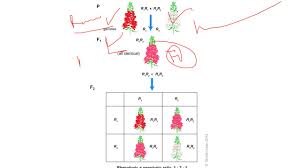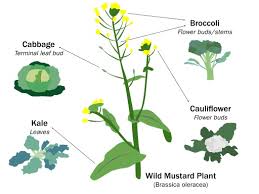Pure line and mass selection methods make use of the existing genetic variability within a specific variety, while hybridization aims to create new genetic variation in plant traits.
Hybridization is a method of crossing two pure line plants with dissimilar genotypes to produce F1 hybrids, followed by subsequent generations, which are segregating generations.
The success or failure of a hybridization program largely depends on the proper selection of parent plants. The genetic consequences of selfing the F1 hybrid are illustrated below. With each successive generation of selfing, heterozygosity is reduced by 50%.
Read Also: How to Grow, Use and Care for Whitetinge Sedge Grass (Carex albicans)
Genetic Consequences of Selfing F1 Hybrid
| Generations | F1 (Heterozygote) Aa x (Selfing) | F2 | F3 | F4 | F5 | F6 |
|---|---|---|---|---|---|---|
| F1 (Heterozygote) | AA | Aa (Heterozygote) | aa (Homozygote) | |||
| F2 | 25% | 50% | 25% | |||
| F3 | 37.5% | 25% | 37.5% | |||
| F4 | 43.75% | 12.5% | 43.75% | |||
| F5 | 46.875% | 6.25% | 46.875% | |||
| F6 | 48.4375% | 3.125% | 48.4375% |
Reduction in Heterozygosity Across Generations

With continuous selfing, heterozygosity decreases and homozygosity increases. For each generation of selfing, half (1/2) of the heterozygosity is converted into homozygosity. The formula to calculate the percentage of heterozygosity remaining is:
(1/2)g where g is the number of generations, and g = n – 1.
For example, in F3:
g = 3 – 1 = 2,
so the remaining heterozygosity in F3 is:
(1/2)² = 1/4 = 0.25 or 25%.
For F5, after applying the formula:
g = 5 – 1 = 4,
the remaining heterozygosity is:
(1/2)⁴ = 6.25%.
In F6, applying the same formula:
g = 6 – 1 = 5,
the remaining heterozygosity is:
(1/2)⁵ = 3.125%.
Pedigree Method of Breeding Self-Pollinated Crops
The pedigree method is used to develop new varieties in self-pollinating crops after hybridization from a segregating population. Individual plants are selected from F2 and subsequent generations, with progeny testing done at each stage. Records of parents and offspring are kept, forming the basis of the pedigree method.
Pedigree Method Handling Process
Year 1: Hybridization is done between two selected parents.
Year 2: F1 seeds are space-planted and selfing is allowed. More F2 seeds are collected from selected F1 plants.
Year 3: In the F2 population, 2000–10,000 plants are space-planted. Select 100–500 plants, harvesting seeds separately.
Year 4: In F3, individual progenies are space-planted with at least 30 plants each. Select desirable plants, eliminating those with undesirable traits, and keep records.
Year 5: F4 progeny rows are grown from selected F3 plants, following the same selection procedure. If two or more progenies from the same F3 progeny are similar, only one is kept.
Year 6: F5 family rows are grown, and undesirable families are eliminated. The best families are kept intact.
Years 7–8: Preliminary yield tests (F6 and F7) are conducted. If good uniformity is observed, proceed to yield and quality tests in Years 9 and 10.
Year 11: Increase seeds and distribute as a new variety.
Modified Pedigree Method for Early Generation Yield Testing
The modified pedigree method follows the same steps as the pedigree method but starts preliminary yield trials earlier, beginning from Year 4 with the F3 population.
Bulk Method of Breeding Self-Pollinated Crops
In the bulk method, after hybridization, the F2 and subsequent generations are harvested in bulk to raise the next generation. Selection is not done during the segregating phases, but delayed until later generations (usually F5 or F6), when heterozygosity is greatly reduced.
At the end of the bulking period, individual plants are selected and evaluated just like in the pedigree method.
Bulk Method Handling Process
Year 1: A cross is made between two parents.
Year 2: F1 plants are grown and harvested in bulk.
Year 3: Starting from the F2 generation, seeds are planted at commercial seed rates and harvested in bulk.
Years 4–6: Portions of the bulk seed from the previous year are planted and harvested in bulk (F3–F5).
Year 7: F6 seeds are space-planted. Select plants using high heritability and qualitative traits, beginning single plant selection.
Years 8–9: Preliminary yield trials are conducted.
Year 10: National yield trials are carried out to identify superior lines, followed by seed increase and distribution as a new variety.
Read Also: How to Grow, Use and Care for Whitegrass (Leersia virginica)
Back-Cross Method of Breeding Self-Pollinated Crops

Back-crossing involves crossing F1 plants with one of the original parent plants. This method is ideal for improving a good variety (adapted variety) that may lack one or two traits. Back-crossing is often used to transfer a single gene, such as disease resistance, from a donor parent to an elite recipient parent.
Genetic Consequences of Repeated Back-Crossing
Repeated back-crossing decreases heterozygosity by 50% in each subsequent generation, leading to an increase in homozygosity. The genotype of the backcross progeny becomes increasingly similar to the recurrent parent.
1. Back-Crossing Process
| Non-Recurrent Parent | Recurrent Parent | F1 Generation | BC1 | BC2 | BC3 | BC4 | BC5 | BC6 | ||||||
|---|---|---|---|---|---|---|---|---|---|---|---|---|---|---|
| Genotype | aa x AA | Aa | Aa x AA | AA + Aa (50%) | Aa x AA | AA + Aa (75%) | Aa x AA | AA + Aa (87.5%) | Aa x AA | AA + Aa (93.75%) | Aa x AA | AA + Aa (96.875%) | Aa x AA | AA + Aa (98.438%) |
2. Transferring Dominant Genes
To transfer a dominant gene (e.g., disease resistance), the recurrent parent (Variety A) is crossed with a donor parent (Variety B) that carries the dominant resistance gene.
Over successive back-crosses, the recurrent parent’s genetic contribution increases, and the gene from the donor parent is incorporated into the population.
3. Transferring Recessive Genes
When transferring a recessive gene, the gene is expressed only in the homozygous condition. Hence, selection and testing are done starting from the F2 generation. This method requires repeated selfing after each back-cross to ensure that the recessive trait is fully expressed.
4. Genetic Calculations for Back-Crossing
The proportion of donor genes remaining after n back-crosses can be calculated using the formula (1/2)ⁿ. For example, after 6 back-crosses, the proportion of donor genes would be:
(1/2)⁶ = 0.015625.
The proportion of the recurrent parent would be 0.984375.
After back-crossing, the resulting variety will appear similar to the recurrent parent but will carry the desired gene from the donor parent, such as disease resistance.
Do you have any questions, suggestions, or contributions? If so, please feel free to use the comment box below to share your thoughts. We also encourage you to kindly share this information with others who might benefit from it. Since we can’t reach everyone at once, we truly appreciate your help in spreading the word. Thank you so much for your support and for sharing!

